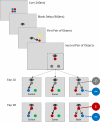Competition in saccade target selection reveals attentional guidance by simultaneously active working memory representations
- PMID: 28134550
- PMCID: PMC5300686
- DOI: 10.1037/xhp0000306
Competition in saccade target selection reveals attentional guidance by simultaneously active working memory representations
Abstract
The content of visual working memory (VWM) guides attention, but whether this interaction is limited to a single VWM representation or functional for multiple VWM representations is under debate. To test this issue, we developed a gaze-contingent search paradigm to directly manipulate selection history and examine the competition between multiple cue-matching saccade target objects. Participants first saw a dual-color cue followed by two pairs of colored objects presented sequentially. For each pair, participants selectively fixated an object that matched one of the cued colors. Critically, for the second pair, the cued color from the first pair was presented either with a new distractor color or with the second cued color. In the latter case, if two cued colors in VWM interact with selection simultaneously, we expected the second cued color object to generate substantial competition for selection, even though the first cued color was used to guide attention in the immediately previous pair. Indeed, in the second pair, selection probability of the first cued color was substantially reduced in the presence of the second cued color. This competition between cue-matching objects provides strong evidence that both VWM representations interacted simultaneously with selection. (PsycINFO Database Record
(c) 2017 APA, all rights reserved).
Figures


References
-
- Cowan N. The magical number 4 in short-term memory: a reconsideration of mental storage capacity. The Behavioral and Brain Sciences. 2001;24(1):87–185. - PubMed
-
- D'Zmura M. Color in visual search. Vision Research. 1991;31(6):951–966. - PubMed
-
- Downing P, Dodds C. Competition in visual working memory for control of search. Visual Cognition. 2004;11(6):689–703. doi:10.1080/13506280344000446.
Publication types
MeSH terms
Grants and funding
LinkOut - more resources
Full Text Sources
Other Literature Sources

